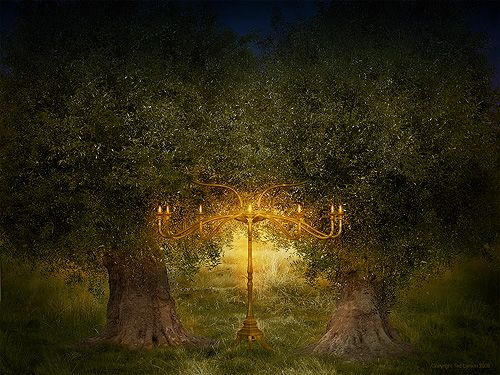These are the two olive trees and the two lampstands standing before the God of the earth.
The Two Witnesses.
Jesus, through the angel speaking to the apostle John, identifies who the Two Witnesses are. To the unenlightened, this sounds like little more than further symbolic claptrap. However, to those who use God's Spirit, which imparts the mind of Christ to His disciples (I Corinthians 2:16), it is a lighted, flashing arrow pointing back to the prophecy found in Zechariah 4.Zechariah 4:14, in summing up the prophecy, parallels Revelation 11:4: "So [the angel] said, 'These [olive trees] are the two anointed ones, who stand beside the Lord of the whole earth." Clearly, the Two Witnesses and their work are revealed in the two olive trees, but understanding this heavily symbolic description takes some effort.

In Zechariah 4:2, the angel describes a strange golden lampstand, somewhat like a menorah—a seven-branched candelabra—but with a large bowl on top. This lampstand features a central pole, on top of which is the bowl, and from it, perhaps in seven different directions, extend seven arms or branches, each ending in a lamp. Further, seven pipes or tubes run to each of the seven lamps from the large bowl on top. Verse 3 informs us that the two olive trees stand to the right and left of the bowl.A similar vision is given to the apostle John in Revelation 1:12-13. In it, the resurrected Jesus Christ replaces the central pole, and the seven lampstands are arrayed around Him, much like the seven lamps. Christ Himself interprets the vision, saying that the seven lampstands are the seven churches (verse 20). However, in this vision, the olive trees are not to be found—they appear separately in Revelation 11. Here, the bowl, too, is missing.Zechariah has no idea what he is seeing, so he asks for clarification. Through the angel, God gives His answer: "This is the word of the Lord to Zerubbabel: 'Not by might nor by power, but by My Spirit,' says the Lord of hosts" (Zechariah 4:6). Zerubbabel, a type of Christ, had been given the work of building the Temple after the Jews returned from exile in Babylon. God's answer to Zechariah is that His work is done through His Spirit.Applying this to the vision, we are to see that the oil that drains from the bowl into the seven lamps represents God's Spirit manifested in works (I Corinthians 12:7-11). We never see the Holy Spirit, since it is invisible to the eye, but we see the works done through it (John 3:8).On this aspect of the prophecy of Zechariah 4, the Kiel and Delitzsch commentary asserts:
"Oil . . . is used in the Scriptures as a symbol of the Spirit of God, not in its transcendent essence, but so far as it works in the world, and is indwelling in the church." Simply put, oil signifies God's Spirit in its visible works rather than in its pure form.Jesus declares an important principle in John 6:63, "The words that I speak to you are spirit, and they are life." One of the primary vehicles of the work of God's Spirit is words—spoken or written. The Bible is inspired by God's Spirit (II Timothy 3:16; II Peter 1:21), and it is a composition of words—God's words, prophets' words, and apostles' words. In the same way, the primary job of an anointed servant of God is to speak or write words to convict people of God's truth. In the speaking or writing of words, he witnesses for God and accomplishes a work.In the case of the Two Witnesses, the two anointed ones, this connection becomes critical. Zechariah 4:12 literally reads, "What are the two olive clusters which through the two golden pipes empty out of themselves the golden oil?" It is an illustration of the olive trees emptying oil into the bowl! How can these two men—prophets though they are—supply the seven churches with oil? Because the oil is not God's Spirit in pure form but Spirit-inspired works, probably in the form of words—teaching, instruction.If this is so, the Two Witnesses provide a massive amount of spiritual instruction to the seven churches just before the end.




